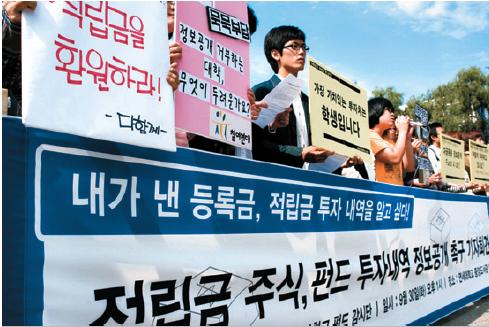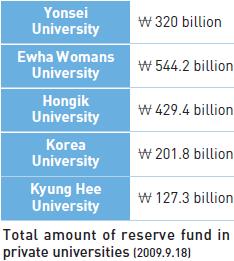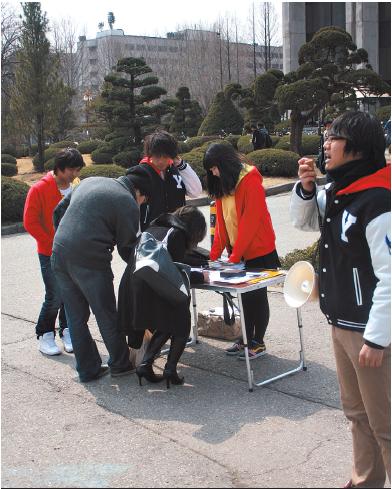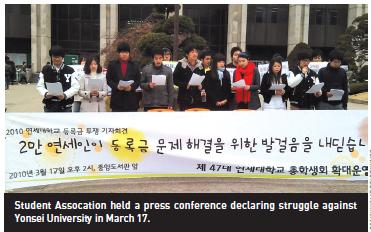An endless argument, are we approaching an agreement?
THE YEAR 2010 is an important year for every Yonseian. Last December, a student of our school and the People’s Solidarity for Participatory Democracy (PSPD)* won a lawsuit against Yonsei University, with the decision to disclose the details of its reserve fund use. Along with this, the Income Contingent Loan (ICL)* and the law limiting increases in the rate of tuition became effective this year. Some might ask, “Do these incidents have any connection with each other?” The answer to this question is, “yes, they do.” Thanks to the students’ strong endeavors, the problems regarding high tuition fees and transparency of school finances is moving towards a solution. At a press conference held on March 17, Jeong Da-hye (Pres., Student Association) said, “Our struggle for reasonable tuition has just started.” At the center of this controversy are concerns about the reserve fund.
* People’s Solidarity for Participatory Democracy (PSPD): A civic group monitoring the authorities, such as the judiciary, and parliamentary politics, in order to prevent corruption and achieve civil rights in our society.
* Income Contingent Loan (ICL): A kind of student loan which lets borrowers begin repayments at the time when they get a job and receive their first income.
Reserve fund coming into the spotlight

A reserve fund refers to “a certain amount of accumulated money for research, scholarship, and construction.” Its main source is donations from alumni and enterprises, while the rest comes from profitable businesses run by the university, such as Yonsei University Milk. When the school is planning certain projects at the beginning of the year, they first include the amount of funds they need in the budget and then collect money. After the reserve fund is prepared, they draw down the required amount of money on particular occasions. For example, when Yonsei University has a plan to construct new buildings on the International Campus (Songdo) or to remodel the old Gymnasium, it needs a large amount of additional expenses in addition to normal operating costs; this is the time when the reserve fund is used. As of 2009, the reserve fund of Yonsei University had reached 246.2 billion.
The first incident that turned the reserve fund into a hot potato dates back to 2005. A National Assembly member announced that Yonsei University had 180 billion of reserve funds, which ranked third among all Korean universities. A group of Yonseians then raised the issue about this unknown fund and gathered the signatures of 2,000 Yonseians. They insisted that the school disclose how they had used the reserve fund and that this large amount of sleeping money should be diverted to relieve the students’ burden of tuition fees. However, the school authorities argued for a different view, based on accounting regulations: Donations that constitute the reserve fund have their own purposes decided from their first receipt, thus it is impossible to use the fund arbitrarily.
There was a similar case in 2008. A student organization in Yonsei University, “Rich School Fund Monitoring,” called for the same request that was made three years previously. At that time, Yonsei University’s Fund Managing Committee had been investing its capital, including the reserve fund, in financial instruments such as deposits, bonds, or funds to maximize the school’s cash flow. However, the school authorities did not seem to worry about the risks of investments and kept asserting that there were no losses through them. Dissatisfied with the school’s attitude, Rich School Fund Monitoring held a press conference and complained that students have the right to know what the school is doing with the reserve fund. In response to their action, the Office of Treasury only revealed a single fact: that 6% of the reserve was invested in funds consisting of stocks and bonds. From 2006 to 2008, the annual tuition increase rate of Yonsei University was 12%, 8.7%, and 8.9% respectively.

The strained relationship between the reserve fund and tuition

Even though private universities keep insisting that revenues earned from tuition fees have nothing to do with the reserve fund, statistical data arouse suspicions about their relationship. When comparing the budget and the closing account from 2004 to 2008, ten major private universities in Seoul showed differences that ranged from 7.1 billion to 78.2 billion. This means that they did not use all the money as planned at the start of the year. Those schools may have reduced or changed plans in expenditures. However, the question raised is why billions of funds left at the end of the year are piled up as a reserve fund, which is against accounting regulations? Experts point out that such large reserve funds cannot be fully made up of contributions. “Many private universities accrue 50~70% of their revenue from tuition. In this sense, they cannot but use tuition in order to accumulate billions of funds every year,” says Lee Jin-sun (Manager, PSPD). In contrast, an official in the Office of Treasury says, “The entire tuition revenue occupies only 50% of the total expenditure. When the tuition revenue is less than the total expenditure, setting aside the remaining tuition is impossible.”
Besides this, the purpose of using the reserve fund is determined by contributors, which prevents the school from using it unnecessarily. Nevertheless, this fact is pointed out as the limitation of reserve funds as well. “We have been continuously requesting for the decrease of tuition, since the amount of the reserve fund exceeds the revenue from tuition. Besides, the small amount of donations that do not have an obvious purpose can be used in subsidizing the tuition,” says Jeong Da-hye (Pres., Student Association, Yonsei Univ.). Nevertheless, they still have a long way to go until the school accepts their suggestions. “The more the reserve fund is accumulated, the more chances of scholarships are given to students. There is no reason to redirect funds to tuition,” says an official in the Office of Treasury.

Tug-of-war over information about fund investment
- Students of Rich School Fund Monitoring requested Yonsei University to disclose information regarding its reserve fund. (September, 2008)
- Information that Yonsei University refused to reveal (October, 2008)
1) Details, purpose, rules of the reserve fund from 2001 to 2008
Reason for refusal: The school had already revealed the kinds of financial packages they were investing in (time deposits, bonds, demand deposits, etc.) through Yonsei Chunchu. In addition, the management of the fund was done in paper documents until 2007, and thus some of them might be missing.
2) The proceedings of the Fund Operating Committee from 1997 to 2008
Reason: It is a commercial secret, according to the Public Information Act. Besides, the proceedings until 2006 were also recorded in paper documents and they are not arranged properly.
- PSPD and Rich School Fund Monitoring filed a lawsuite against Yonsei University. (March, 2009)
- The court ruled in favor of the plaintiff . (December, 2009)
The court’s decision about the case
1) Yonsei University showed only rough information about the reserve fund: the entire amount of funds and proportion for each investment asset. Therefore, it is hard to figure out detailed information about how the school has managed the fund.
2) Private universities are responsible for guaranteeing the people’s right to know. As public entities, they have to keep their finances and accounting transparent.
- Yonsei University appealed against the court's decision. (February, 2010)
Reasons for appeal
1) In making investments with the school fund, not only the reserve fund but also money from other sources is included. Therefore, it is hard to estimate the exact amount of the reserve fund invested in each financial instrument.
2) Financial institutions might notice Yonsei University’s propensity to invest if the core documents are open to the public. This may harm the school’s proper future investment.
3) The amount of money the school needs for the year is presented through the budget statement. In other words, the budget statement itself shows the grounds for raising the tuition.
Efforts to settle down the problems

From 2010, the government will enforce modified accounting regulations for private universities. According to the new law, private universities should separate tuition accounting and fund accounting. In addition, the result of investing in financial instruments must be open to the public regardless of their loss rate. Until last year, schools had a duty to reveal their loss rate for investing only when the loss was over 50%. “We hope that more transparent accounting is achieved, while eliminating suspicions of students over setting the tuition fee,” says Lee Suk-hyun (Deputy Director, Private University Support Div., Ministry of Education, Science and Technology (MEST)). Although the government has shown efforts in controlling private universities’ accounting, this is not sufficient. The fundamental problem is that the government does not fund universities much. According to the average public educational expenditure of countries in the OECD, about 1.0% of GDP is supported by the government. As for Korea, however, the government bears only 0.6%. Jeong Kap-young (Prof., Dept. of Econ.) also demands government action. “Considering that Korea is aiming to enter the top 10 in GDP rankings, private universities should be funded by the government to the level of average OECD countries, or even more. Universities foster elites and research infrastructure, contributing to society. Therefore, limiting the tuition increase rate cannot be an ultimate solution without the government’s financial aid.” An official of MEST says, “Many developed countries in Europe have a higher proportion of national universities, so their government funding for higher education is larger. They also have lower college entrance rates. Being in different circumstances, it is impossible to compare Korea with these countries directly. In order to increase to the OECD average, 13 trillion is needed. Such a considerable amount of money cannot be accumulated instantly.”
In addition to the government’s assistance, the school authorities should arrange a meeting for students to discuss the process of tuition pricing. “Tuition is not an individual burden anymore, but a social issue. As clarified in the revised version of the Higher Education Act, each university should organize a Tuition Pricing Committee and establish clear standards of pricing tuition,” says Kim Young-min (Former administrator, Rich School Fund Monitoring). Besides, reserve fund usage needs to be revealed to the students not occasionally, but at all times. As for managing funds, a scholarship quota system is brought up as a promising solution. By increasing the proportion of scholarship funds, students will be given more chances to receive scholarships.
A revised version of the Higher Education Act (January, 2010)
- All universities should establish a Tuition Pricing Committee composed of the school authorities, students, and relevant experts in order to set a reasonable tuition fee rate.
- The committee should fix the tuition fee based on an average city worker’s income, educational expenses per student, etc.
* * *
There are still a lot of obstacles to surmount for the students and the school in order to reach an agreement on tuition issues. Each party may have their own circumstances and reasons, but there is one thing that every Yonseian has to remember: Tuition has now become a matter of survival. “I’m realizing the harsh realities of life. The hourly wage of a convenience store is 2,700, and 3,500 for working as a part time…” This is from a letter written by a female college student sent to Pres. Lee Myung-bak. It is time for us to seriously consider what the best way is for students who cannot even study freely, whilst eking out a living.
Kim Min-ju
lovejen6@yonsei.ac.kr

